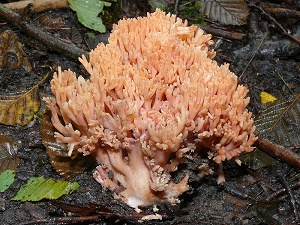| Ramaria formosa (Fr.) Quél. |
|
|
|
|
|
|
The fruiting body is shaped like a branched shrub, with cylindrical branches, brown-pink to pink-orange, without stem, but with a thick trunk, white with pinkish shades, on white mycelial strands. The fertile surface is smooth. It grows on the ground, in broad-leaved woods, with beech, ash. The fruiting period takes place from August to December.
Distinctive features : branched; with pink and yellow branches, and lemon yellow tips; branchings U-shaped (not V-shaped); bitter or acid taste; white flesh becoming vinaceous red when cut Ramaria formosa is rare and confined in the forest of Rambouillet, and is quite rare, more generally speaking . | ||
|
page updated on 14/01/18

